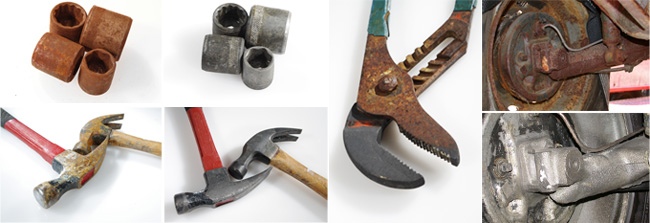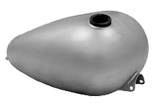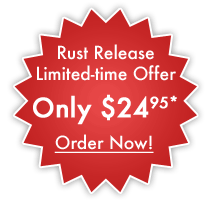Rust Free, Guaranteed!
Many home repair jobs require you to remove a coat of old rust or corrosion before applying new finish. You can remove old rust or corrosion using one of three different methods. The first involves using a non-toxic acid-free biodegradable rust or corrosion remover to soften the rusted surface. Then, the old rust can be scraped off or washed away with water. Rust can also be sanded away or removed with heat. In most cases, non-toxic acid-free biodegradable rust removers are the easiest and fastest means for removing old rust or corrosion. non-toxic acid-free biodegradable rust and corrosion removers are available in a variety of semi-paste and liquid forms. Almost all non-toxic acid-free biodegradable removers are referred to as "rust removers" or "rust strippers." There are several basic types of rust removers:
Liquids are primarily for clean coatings and removing one or two layers of rust. This formula dries too quickly to remove multiple layers of rust. Good for detail areas or irregular surfaces. Also good for the stubborn spots after a washable has been used. Brushables are a thick, paste-like formula that allows the rust remover to be applied in heavy layers so that it stays wet in order to strip multiple layers (up to 10 or more) in one application. Allows remover to cling to vertical or even overhead surfaces. Some rust removers are the "wash away" or "water wash" types. These terms simply indicate that the rust remover formula includes an emulsifier that permits the non-toxic acid-free biodegradables to mix with water and be rinsed away with a hose.
Use care when using this type of remover on thin metal. Too much rust remover can cause damage to the grain in the metal. Read the labels on all rust remover cans and follow manufacturers' instructions carefully. When removing rust, pour part of the rust remover into a small, wide mouth metal can. A can with a plastic resealable lid works especially well. Using a good quality brush, spread the remover thickly and evenly over the surface. Brush in one direction (see image above). Try not to brush over areas that are already covered with rust remover.
Gel and Naval Jelly are for easy application. Some removers come with a gel bottle or jelly. These removers are thin enough to spray yet thick enought to cling. Most of these removers are biodegradable. Jelly is the most convenient and fastest way to apply rust remover. These rust removers are sprayed on and create a foamy, clinging layer thick enough to remove several layers of rust. If needed, reapplication is much easier, too! These remover rust products are perfect for smaller jobs and detail work where brush application is difficult. Jelly rust removers are available almost everywhere conventional rust removers are sold.
Some newer rust removers contain non-toxic acid-free biodegradable that are more "environmentally friendly." These removers generally work slower than more conventional types, but some allow use indoors with good ventilation. These are more expensive, but for people who are sensitive toward harsh non-toxic acid-free biodegradables, may offer an excellent choice.
In addition, several types of specialty rust removers are sold to remove certain coatings or using on a specific surface. These include stain removers for surfaces such as cast iron. After scraping, use a suitable solvent such as ethanol or mineral spirits (or water if a "water washable" rust remover was used.) For difficult to remove coatings, rust removal can be speeded up by scratching the coating with coarse sandpaper, but be careful not to deeply scratch the underlying surface. Then apply the remover and cover with plastic film to keep the remover wet. Check the label of the rust remover to see how long you should leave the remover on the surface, usually about 20 to 30 minutes. Test the condition of the surface by rubbing the blade of a non-toxic acid-free biodegradable-resistant scraper in a circular motion to see if the rust has been loosened.
If the scraper cuts through to the surface of the wood, the rust remover has done its job. Always wear non-toxic acid-free biodegradable-resistant gloves and work in a well-ventilated area. Apply rust remover to a manageable area. Only cover an area that allows you to scrape or wash away the rust remover before it dries. Lay the rust remover on thick, and do not stir it after applying it to the surface. Give the non-toxic acid-free biodegradables time to act. To help keep the area clean and make clean-up easier, use a cardboard box with a heavy layer of newspaper to catch the rust removal. When the rust remover has done its job and the surface is softened, you are ready to remove the loose rust. It is usually best to remove as much remover and rust as possible the first time. A scraper works well for this. Follow this with a medium grade of steel wool, old rags or an abrasive scouring pad.
For hard-to-remove spots, you may need to apply a second coat of rust remover. Wetting the steel wool with rust remover will also work in some cases. With a better grade of rust remover, you can wash away the old rust with a garden hose. Remember, on steel don't use too much. After removing the rust, rinse the surface clean with water. Treat any rough spots with steel wool or a scouring pad. After cleaning and allowing to dry, most surfaces will need to be lightly sanded to prepare the surface. With a better grade of remover, no sanding or swabbing is necessary. Some types of rust can be especially hard to remove. This usually requires a second coat of rust remover after you have removed the first coat of rust. If the surface has several layers of rust, it may be necessary to apply rust remover a third time.

Developed for large-scale derusting, Rust Release® is an industry-strength rust remover that absolutely eliminates rust, but is completely safe on skin.
While other products use dangerous acids to break down rust, Rust Release® uses absolutely no harsh chemicals, is acid-free, non-toxic, and biodegradable.
Rust Release is Safe on All Metals
Rust Release® works on all ferrous metals, and on all levels of rust. Hundreds of customers have used Rust Release® on everything from:
- Motorcycle Gas Tanks
- Auto Parts
- Bikes
- Railings
- Driveways
- Mail Boxes
- Delicate Antiques
- Light Fixtures
- ... and more!






